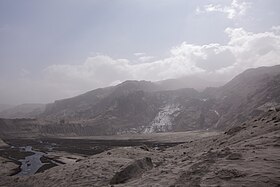Eyjafjallajökull
| Eyjafjallajökull | |
|---|---|
| Guðnasteinn Hámundur |
|

Gígjökull, Eyjafjallajökull's largest outlet glacier covered in volcanic ash
|
|
| Highest point | |
| Elevation | 1,651 m (5,417 ft) |
| Coordinates | 63°37′12″N 19°36′48″W / 63.62000°N 19.61333°WCoordinates: 63°37′12″N 19°36′48″W / 63.62000°N 19.61333°W |
| Naming | |
| Pronunciation | Icelandic pronunciation: [ˈeɪjaˌfjatlaˌjœːkʏtl̥] |
| Geography | |
| Location | Suðurland, Iceland |
| Geology | |
| Mountain type | Stratovolcano |
| Volcanic arc/belt | East Volcanic Zone |
| Last eruption | March to June 2010 |
Eyjafjallajökull (Icelandic pronunciation [ˈeɪjaˌfjatlaˌjœːkʏtl̥]), English Eyjafjalla Glacier, is one of the smaller ice caps of Iceland, north of Skógar and west of Mýrdalsjökull. The ice cap covers the caldera of a volcano with a summit elevation of 1,651 metres (5,417 ft). The volcano has erupted relatively frequently since the last glacial period, most recently in 2010.
Eyjafjallajökull consists of a volcano completely covered by an ice cap. The ice cap covers an area of about 100 square kilometres (39 sq mi), feeding many outlet glaciers. The main outlet glaciers are to the north: Gígjökull, flowing into Lónið, and Steinholtsjökull, flowing into Steinholtslón. In 1967 there was a massive landslide on the Steinholtsjökull glacial tongue. On 16 January 1967 at 13:47:55 (or 1:47:55 pm) there was an explosion on the glacier. It can be timed because the seismometers at Kirkjubæjarklaustur monitored the movement. When about 15,000,000 cubic metres (530,000,000 cubic feet) of material hit the glacier a massive amount of air, ice, and water began to move out from under the glacier into the lagoon at the foot of the glacier.
The mountain itself, a stratovolcano, stands 1,651 metres (5,417 ft) at its highest point, and has a crater 3–4 kilometres (1.9–2.5 mi) in diameter, open to the north. The crater rim has three main peaks (clockwise from the north-east): Guðnasteinn, 1,500 metres (4,900 ft) ; Hámundur, 1,651 metres (5,417 ft); and Goðasteinn, 1,497 metres (4,911 ft). The south face of the mountain was once part of Iceland's coastline, from which, over thousands of years, the sea has retreated some 5 kilometres (3 mi). The former coastline now consists of sheer cliffs with many waterfalls, of which the best known is Skógafoss. In strong winds, the water of the smaller falls can even be blown up the mountain. The area between the mountain and the present coast is a relatively flat strand, 2 to 5 km (1 to 3 miles) wide, called Eyjafjöll.
...
Wikipedia

